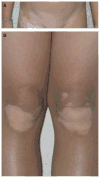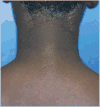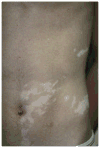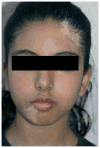Revised classification/nomenclature of vitiligo and related issues: the Vitiligo Global Issues Consensus Conference
- PMID: 22417114
- PMCID: PMC3511780
- DOI: 10.1111/j.1755-148X.2012.00997.x
Revised classification/nomenclature of vitiligo and related issues: the Vitiligo Global Issues Consensus Conference
Abstract
During the 2011 International Pigment Cell Conference (IPCC), the Vitiligo European Taskforce (VETF) convened a consensus conference on issues of global importance for vitiligo clinical research. As suggested by an international panel of experts, the conference focused on four topics: classification and nomenclature; definition of stable disease; definition of Koebner's phenomenon (KP); and 'autoimmune vitiligo'. These topics were discussed in seven working groups representing different geographical regions. A consensus emerged that segmental vitiligo be classified separately from all other forms of vitiligo and that the term 'vitiligo' be used as an umbrella term for all non-segmental forms of vitiligo, including 'mixed vitiligo' in which segmental and non-segmental vitiligo are combined and which is considered a subgroup of vitiligo. Further, the conference recommends that disease stability be best assessed based on the stability of individual lesions rather than the overall stability of the disease as the latter is difficult to define precisely and reliably. The conference also endorsed the classification of KP for vitiligo as proposed by the VETF (history based, clinical observation based, or experimentally induced). Lastly, the conference agreed that 'autoimmune vitiligo' should not be used as a separate classification as published evidence indicates that the pathophysiology of all forms of vitiligo likely involves autoimmune or inflammatory mechanisms.
© 2012 John Wiley & Sons A/S.
Figures






References
-
- Attili VR, Attili SK. Lichenoid inflammation in vitiligo – a clinical and histopathologic review of 210 cases. Int J Dermatol. 2008;47:663–669. - PubMed
-
- Barona MI, Arrunátegui A, Falabella R, Alzate A. An epidemiologic case-control study in a population with vitiligo. J Am Acad Dermatol. 1995;33:621–625. - PubMed
-
- Boissy RE. Vitiligo. In: Picardo M, Taieb A, editors. Occupational vitiligo. Heidelberg: Springer Verlag; 2010. pp. 175–180.
-
- Boissy RE, Manga P. On the etiology of contact/occupational vitiligo. Pigment Cell Res. 2004;17:208–214. - PubMed
-
- Boissy RE, Nordlund JJ. Biology in vitiligo. In: Arndt KA, LeBoit PE, Robinson JK, Wintroub BU, editors. Cutaneous Medicine and Surgery: An Integrated Program in Dermatology. Philadelphia: W. B. Saunders Company; 1995. pp. 1210–1218.
Publication types
MeSH terms
Grants and funding
LinkOut - more resources
Full Text Sources
Other Literature Sources
Medical
Research Materials

